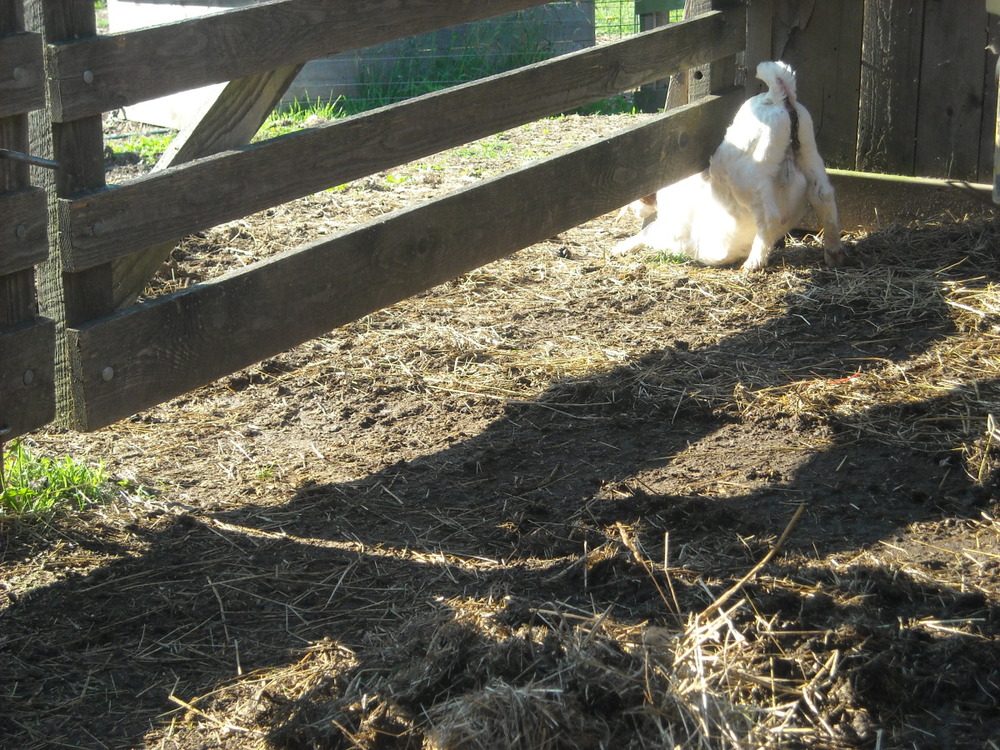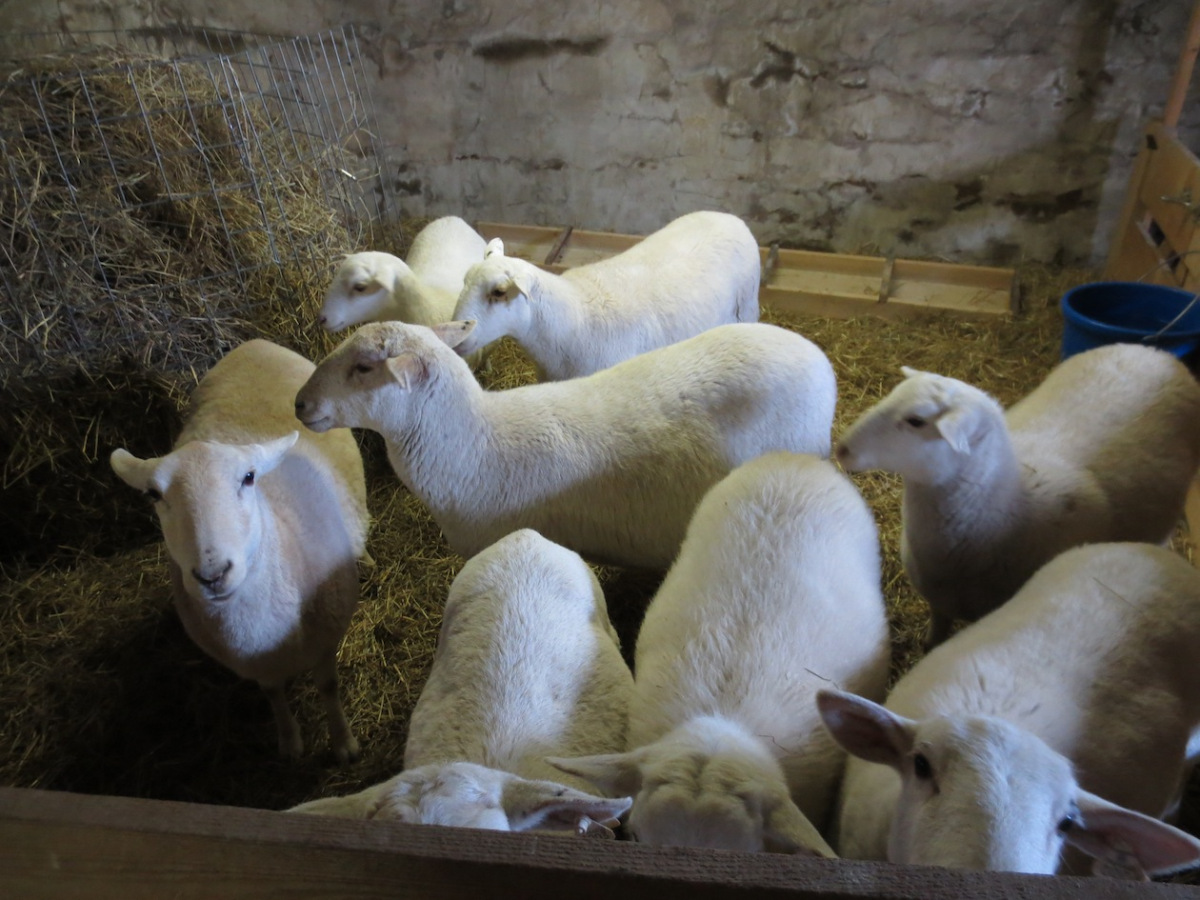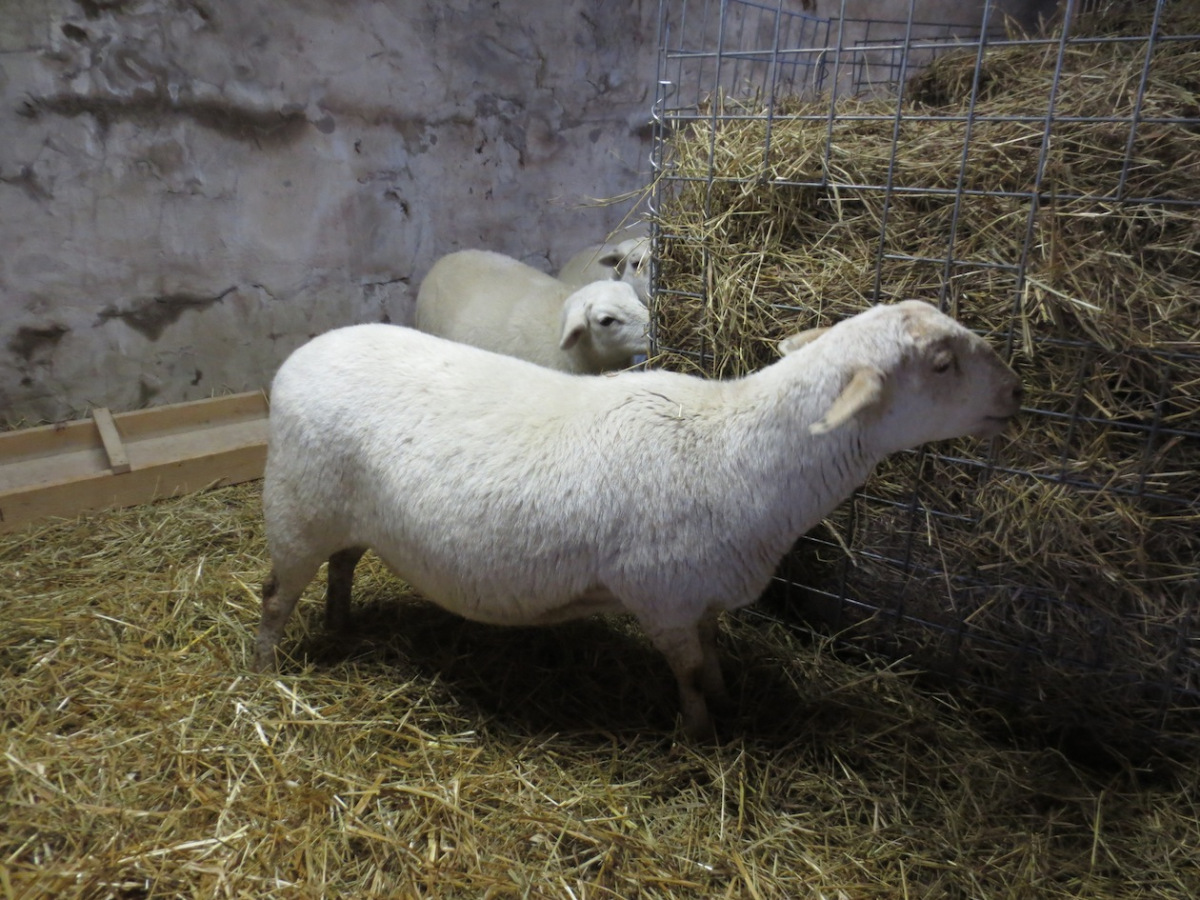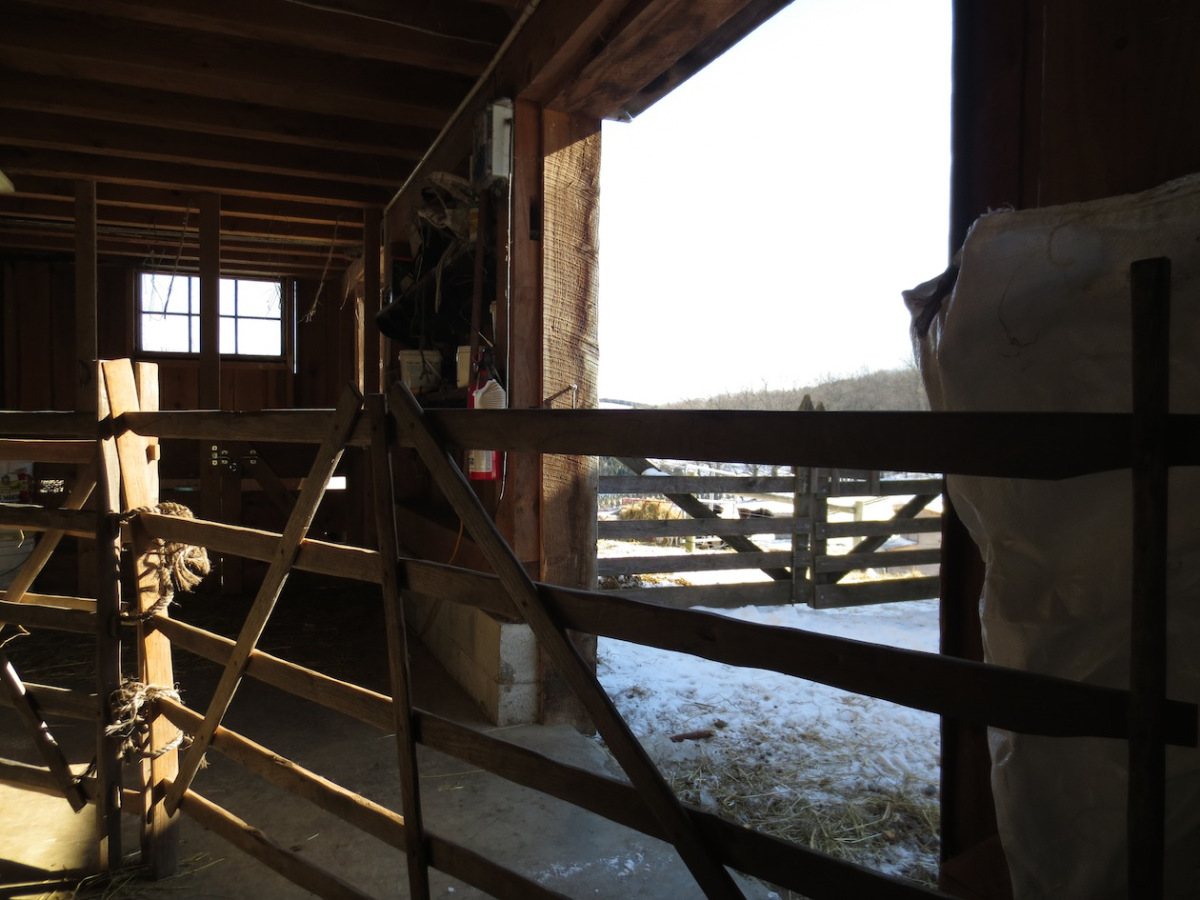Gretel and the kids have been sold to a 4H family. The dad said his son shows pigs, rabbits and sheep and wants to add goats to the mix. Originally goats were here to tame the multiflora rose and trim the edges of the woods. My mattock effectively grubs out the brambles and cows and sheep graze the forest edges, all with minimal fencing. We will miss Gretel's curiosity and the kids' hilarious antics and affection.
A winter break
Lilac Hill farm in late winter is all about food, water, shelter and waiting. Waiting for kids and lambs, waiting for nest making and eggs, and waiting for the first bits of green in the pastures. Already the days have lengthened and evening chores are not completed in the dark.
In spite a false alarm when I was away from the farm for 6 days, Gretel waited to kid until the week after my return.On Sunday the 24th Gretel kidded. Ernest (6#) and Cecily (8#) arrived without complications. Unfortunately Gretel's colostrum was too thick for them to nurse so we thinned the milked colustrum and bottle fed it to the Wilde kids (my daughters' name choices were inspired by Ocsar Wilde's "The Importance of Being Ernest") in front of a warming fire. The kids spent the first night in the house then were returned to the barn. All this intervention was guided by our friend, Mike, with years of goat experience and who just happened to come to dinner on Sunday. Gretel came from Mike's farm years ago.
Although we do not see the Wilde kids nurse, they do have milk in their bellies and are very active.
The Katahdin ewes have benefitted from a grain ration at the end of their pregnancies. At the end of January I noticed that the ewes, especialy the yearlings (also know as theaves or gimmers), were losing condition on a hay only diet.Because I needed to put the ram in with the ewes a month early last fall (Burgess' field companion died unexpectedly), the yearlings needed the added nutritional support as they continue to grow while pregnant. Daily, close contact, especially with delicious grain, has gentled the flock and even my shiest Katahdins tolerate closer handling. The older two ewes, Maude and Mab, are obviously getting ready to lamb. It is harder to judge the readiness of the theaves.
A break in the weather
With yesterday's warming (and sleet and rain and mist) running water returned to the barn hydrant.
To avoid sore feet or twisted legs, I will keep the pregant girls, the ewes and Gretel, in the barn. The ram and wethers will stay have access to the barnyard, but not the field with Murphy, the donkey and the Belties. With warming on the way and mud in my future, I will get a round bale out to the cows today.
The new batch of round bales are heavier and mostly Timothy. The larger bales last alot longer limiting skid steer traffic and during the coldest temperatures and the last weeks of pregnancies,when nutritional needs are high, my animals benefit.
Arctic Blast
The last week has found us in the clutches of bitter temperatures. When the temperatures dip into the single digits my barn water hydrant freezes and the frozen waterfowl troughs become too heavy to dump. Fortunately the hydrant in the boat barn is reliable and uphill from the heated field trough so draining the hose after use is easy. Until the duck and goose "ponds" melt a bit, the fowl must be content with buckets of water drawn from the cow and donkey trough. I placed the round bale of hay closer to the hill to provide northly protection from the wind.With the Katahdins and Gretel nearing the end of their pregnancies, I have changed my management practices. Gretel's earliest due date is in the middle of February. She overnights in the goat pen to avoid excess jostling and eats her portion of grain without competition. During the day she roams the barnyard for exercise, eats hay from the round bale feeder and lies in the sun. The ewes now overnight in a paddock fashioned at the bottom of the barn with two pen specific gates and two panels from the trailer pen.The ewes have two 8' troughs set up along the back wall of the barn for their portion of grain. With 16' of trough there is plenty of room for all the ewes to eat without competition. A much distressed Burgess now beds down and eats with the wedding wethers. During the coldest nights I keet the sheep and goats closed in the bottom of the barn. I set up the 4 hurdles as a moveable chute for guiding the ewes and goat away from the bins of grain and out to the paddock. In spite of the frigid temperatures I keep the sheltered door open during the day to welcome in the sun.
Becoming a shepherd is a humbling endeavor. It requires that I observe the sheep, looking for clues to conditions I often do not know exist. For example, I noticed that the yearlings' bellies were rounding, but missed that their condition score was dropping until I ran my hand along their bumpy spines. According to the advice of my books I had planned on starting to feed grain during the last week of January but, experience would have told me to start a week or two earlier. As LHF grows, so will our handling facilities. With more secure fenced fields I will be able separate the yearlings for later breeding dates, to avoid stressing their growing bodies with early first lambings. As my flock grows, staggered lambing dates will also allow me to use the pens that I have without overcrowding. My winter reading list reflects my deficiencies as a shepherd. I have been reading about nutrition and the types of hay best suited to the needs of the sheep, hoping that I will know what to look for when looking at a field ready to be cut and a round bale offered for sale. At a workshop sponsored by Fertrell's I paid particular attention to the talk about feeding small grains to rumninants. I have also been reading about lambing and watching youtube videos to refamiliarize myself with lambing-normal and troubled. Hopefuly when faced with an unexpected problem I will be able to manage and add another "thing" I notice as I tend my sheep.
Gretel returns
Gretel has returned from her visit with the Boer buck. She is in fine form and reasserting her dominion over the barnyard. Yesterday when the sheep trotted in from grazing in the orchard she pushed them around the hay feeder as if to remind themthe flock, including Burgess the ram, who was in charge.
Charlie's companion
While Gretel is visiting the Boer buck, Shamrock has come to keep Charlie company. After some head butting and foot stomping, the goats have settled in. Although only half Nubian, Shamrock is more verbose, calling whenever she sees a human in the yard.When breeding seaosn is complete, we will swap Gretel and Shamrock.
Why goats at LHF?
 The goats on our farm are a leftover from our early days of animal husbandry. My vision of having the goats keep the fencelines clear collided with the realities of keeping up with goat fence management.I found electronet a reliable fencing method when rampant spring grass and too many polywire paddocks did not draw off charge from the energizer and when the fenceposts were not damaged by hard summer ground. Gretel, our remaining bottlefed Nubian, prefers to oversee the farm and that is best done from her barnyard paddock.
The goats on our farm are a leftover from our early days of animal husbandry. My vision of having the goats keep the fencelines clear collided with the realities of keeping up with goat fence management.I found electronet a reliable fencing method when rampant spring grass and too many polywire paddocks did not draw off charge from the energizer and when the fenceposts were not damaged by hard summer ground. Gretel, our remaining bottlefed Nubian, prefers to oversee the farm and that is best done from her barnyard paddock.
Hansel's death left Gretel as the lone goat in the field so we bred her to Boer buck anticipating caprine companionship for Gretel and meat for our freezer. Our goat plans have changed as our farmstead has grown.Cleaning out the secure goat yard is less frustrating than fighting with fence and losing landscaping to escaped goats. As a bottle fed animal, never destined for the freezer, Gretel stays on the farm, hopefully producing meat for the freezer and occasionally clearing some fencelines and overgrown garden beds with Charlie, this year's goat sidekick. 
Goats on the far hill

 This morning both goats were happily brousing the weeds when I brought their morning kibble. They prefer to share one bowl and in spite of Charlie's smaller size, he gets his fair share thanks to the persuasiveness of his one inch horns. Gretel is happy in the company of another goat.
This morning both goats were happily brousing the weeds when I brought their morning kibble. They prefer to share one bowl and in spite of Charlie's smaller size, he gets his fair share thanks to the persuasiveness of his one inch horns. Gretel is happy in the company of another goat.
New Boer Goat, Charlie
 Gretel our bottle fed Nubian did not kid this year and has not bonded with the sheep, donkey or cows so she is lonely. Today I brought home a purebred Boer wether to keep her company. Charlie. Charlie is not a barn pet and will leave the farm in the fall, just in time for Gretel to visit the buck before winter. Gretel is a barn pet and will remain on the farm, hopefully kidding once a year and keeping the fence edges broused.
Gretel our bottle fed Nubian did not kid this year and has not bonded with the sheep, donkey or cows so she is lonely. Today I brought home a purebred Boer wether to keep her company. Charlie. Charlie is not a barn pet and will leave the farm in the fall, just in time for Gretel to visit the buck before winter. Gretel is a barn pet and will remain on the farm, hopefully kidding once a year and keeping the fence edges broused.














